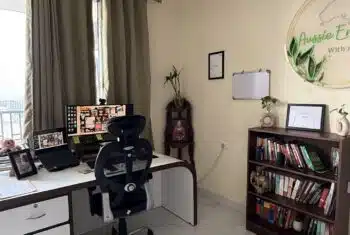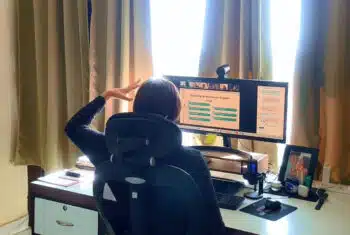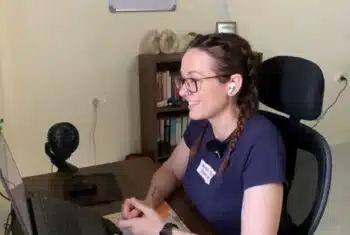The Realities Of Teaching Online: Tips, Challenges And A Success Story
Join a global community of over 200,000 TEFL teachers working throughout the world! Enrol me!
Teaching online is ridiculously popular. We bet you probably know at least one person doing it right now. Some think it’s easy: just log in, chat, and log out. Sure, sometimes it really is just that simple, but more often than not, there’s a lot more going on behind the screen.
We spoke to Amanda, a Certified Accent Specialist from Australia. She’s been teaching English online since the COVID-19 pandemic in 2020 and holds a Level 5 TEFL qualification from The TEFL Academy.
Having worked for several online platforms, she’s going to help us hack the online teaching world, so that you don’t have to.
Read more: Online Teaching Platforms You Need To Know
Let’s crack that code, Amanda!

Amanda’s journey into online teaching
Amanda: Hi, I’m Amanda, an Australian ESL teacher. I’ve been teaching online for almost five years. I moved to India when the pandemic started.
During the COVID lockdowns, I felt lonely, isolated, and missed human interaction. I wanted to work, but everything was shut down, and I needed something flexible that I could do on my terms.
I came across a YouTube video about how to apply to Cambly, a conversational English platform. I applied and was approved within 24 hours. I didn’t realise it would be so quick and didn’t even have a webcam or headset. So I rushed out to get those and opened my schedule the next day.
Read more: Teaching On Cambly: What You Need To Know
While on Cambly, I created a profile on AmazingTalker where I could set my own rates. I also used Engoo to fill gaps in my schedule. I preferred it over Cambly as the classes were shorter (25 minutes vs 30 minutes). Also, the no-show/late cancellation rate was better.
Now that’s good inside knowledge!
In May 2024, I went fully independent and now work for myself. I didn’t have any teaching experience before this – I used to work in insurance claims back in Australia.
That’s three platforms in just over three-and-a-half years!
Amanda’s journey is an inspiration to those with zero experience. She shows that all you need to do is take the plunge and test out a few different platforms. You may even feel motivated to start your own tutoring business!
Of course, everyone’s experience is different, and the world of online teaching may initially come with a few surprises.
Read more: What Are The Requirements For Teaching English Online
Common challenges online English teachers face
How was your first week of online teaching?
To be honest, I was nervous.
I had joined the Cambly Corner Facebook Group and saw many horror stories about tutors experiencing inappropriate behaviour from students.
Apparently, this used to happen often because Cambly offered free trials. They’ve since changed this policy and now have the camera turned off for trial calls as a safety measure, and tutors can choose if they wish to answer trial calls or not.
During my first few classes, my husband often checked that I was okay. Luckily, nothing bad happened.
I was having so much fun.
It felt amazing connecting with people again and helping them improve their English. I’ve always worked in customer service, so I thrive on helping others.
Read more: 9 Best Places To Teach English Online With No Experience
The hidden side of online teaching
Technical issues
Thank goodness for Facebook groups like Cambly Corner and Reddit threads. I learned that if there’s a video lag or delay, asking the student to turn off their video usually helps.
Read more: Tips For Setting Up An Online Classroom
Setting boundaries
Some students will ask you to teach outside your regular schedule or message you at odd hours, and being a people pleaser, I would always say yes or reply.
When I upgraded my phone, I turned my old one into a work phone with a separate SIM. I leave it in my office after hours and set up an “out of office” message on WhatsApp, so students know I’m unavailable.
Inappropriate student behaviour
This happened to me twice in my first two years on Cambly. No course ever prepared me for how to deal with that, but thankfully, other teachers in the Facebook group explained what to do — you can report, block, and ban the student immediately.
Read more: Netiquette For Teaching English Online
An online teacher wears many hats. You need to be your own IT department and counsellor. Seeking out online teaching support communities on social media platforms is a great way to share your struggles and get tips. Real-world experiences teach lessons a course can’t.
Have you ever had to stall or improvise mid-class?
Yes, definitely.
If there’s video lag, I can still follow what’s going on. I just smile and nod while waiting for the connection to stabilise.
If I missed something, I’m honest and ask them to repeat it due to a connection issue. Students are usually very understanding.
If Zoom is acting up badly, I’ll switch to Teams or Google Meet.
I recently had a student whose internet was so poor that I just said, “Let’s reschedule.” It was the first time this happened to her. Her previous lessons were fine, and I didn’t want her to waste her class time — the beauty of being independent is having the flexibility to treat students fairly.
Read more: What Internet Speed Do I Really Need To Teach English Online?
In my part of India, power cuts are common. I have a power backup installed to keep my wifi connected.
If my network resets mid-class, I message the student on WhatsApp to explain, then stay back a few extra minutes to make up the time.
I also have a Google Document with each student’s lessons, so if my screen share isn’t working, I’ll usually ask them to open it from their side and follow along with me.
Keep calm and carry on seems to be the online teacher’s motto! Tech hiccups are just part of the deal, so back-up plans are a must.
But sometimes student behaviour can also challenge you.
How do you deal with awkward silences, unresponsive students, or blank screens?
I use a question generator tool to get students talking, then I follow up with WH- questions to help them open up more. I’ll also talk about cultural differences between Australia and their home country – students usually love that topic.
Worst-case scenario, I ask about their weekend plans and build a conversation from there.
I honestly don’t mind cameras being off, unless it’s a pronunciation lesson, in which case I tell them that I need to see their mouth moving. Otherwise, it’s their choice.
Read more: 5 Potential Problems In The Online Classroom And Their Solutions
Having a list of conversation topics on standby is a great way to keep lessons engaging. Remember, not everyone loves being on camera, so go with what your students are comfortable with.
And while you’re keeping your students engaged, don’t forget about your admin. Between back-to-back lessons and sneaking in a coffee, it’s easy for it to slip under the radar and suddenly pile up.
What’s one admin task you always forget (or dread) when working online?
I dread checking pronunciation homework. It’s not something that can be automated. I have to listen and provide detailed feedback, and it’s just very time-consuming.
Admin is a necessary evil in every teacher’s life. Amanda’s picked up some clever ways to cut down the time it steals.
Admin shortcuts
- Spontaneous speech recordings: I upload spontaneous speech recordings into a transcription tool, so I can read and listen at the same time. It makes the process faster.
- Custom GPTs: I’ve tried to automate as much admin as possible. I’ve created custom GPTs to help with tasks. For example, after a lesson, I upload the transcript into my lesson summary tool, which generates a summary with learning outcomes, new vocab, pronunciation or grammar feedback, and homework.
- Time blocking: I block time in my calendar for admin each day, so it doesn’t pile up.
These innovative tricks are a nifty way to reduce the workload.
Read more: 7 Easy Steps To Being A Successful Independent Online English Teacher
What’s the strangest place you’ve taught a lesson from?
Honestly, I’ve never taught from anywhere strange. I don’t like the idea of teaching from a café or co-working space where there could be noise, distractions, or people overhearing my class.
If I can’t be in a private space, I’d rather reschedule.
That said, a few years ago, we were moving apartments — same complex, different building. (The new apartment doesn’t have great mobile reception, so if my wifi ever drops out, I can’t use my phone as a hotspot.)
Back then, we hadn’t yet set up the internet in the new place, so I’d race back up to the old, empty apartment with just a small round dining table in the middle of the room. I’d connect to my phone’s hotspot and teach my classes from there.
Read more: How To Overcome Online Teaching Challenges While Travelling
Talk about dedication! Improvising in a sticky situation is the kind of quick thinking that online teachers need.
Have you ever taught at an unusual hour?
Yes, many times. That’s actually why I eventually had to set boundaries.
The latest was 11 pm IST (Indian Standard Time).
My student was in the same time zone, but it was the only time he was free. I took it because I was thinking about the money (back when I was on Cambly).
I also taught 6 am classes every Tuesday for another student in India. It was really hard; I was always tired and trying not to yawn. I would mix protein powder into my coffee to give me a caffeine boost, but also double as a light breakfast.
Eventually, I told both students I couldn’t continue outside my scheduled hours.
Have you ever taught a lesson while sick, exhausted, or emotionally drained?
Yes, especially on platforms like Cambly and Engoo where you’re penalised for last-minute cancellations, or on AmazingTalker where you have to teach a lot just to reduce their commission.
Read more: Online Teaching Jobs Salary: How Much Can You Really Earn?
When I wasn’t feeling 100%, I always felt guilty that I couldn’t give my best.
But that’s what I love about working independently — if something comes up, I just tell the student honestly and ask to reschedule. They’re usually very understanding.
I often offer an alternative time slot on my day off if I’m fully booked for the rest of the week.
Organisational skills are so important, but so is your mental health. It’s easy to get caught up in the hustle culture, so knowing when to slow down is essential to keep performing at your best.
Read more: 7 Steps To Creating A Work-Life Balance For Teachers
What’s your go-to move between lessons?
I first update my spreadsheet – I log what we did in class and what we’ll do next time. I also use that to track how many lessons a student has left in their package.
Then, I stretch, refill my water bottle, and make tea or coffee.
Smart move. Hydration is great for a quick recharge. Travel mugs are great to keep keyboards safe from spillage.
But beyond the occasional caffeine cravings, what other surprises could steal an unsuspecting teacher’s attention mid-lesson?
What’s your biggest distraction while teaching?
The army jets.
Okay, we weren’t expecting that one!
I live near an airport and air force base, so sometimes they fly over and they’re super loud. Students can’t usually hear them, but I mute myself just in case. If I’m the one talking, I try to stay focused and not get distracted.
Sometimes the balcony door is open, and when my husband opens the lounge door that leads to it, all three of my dogs come running in to see me. My students usually laugh and ask to meet the dogs.
If my doorbell rings and I’m home alone, I’ll sometimes step away to answer it, then stay a few minutes after class to make up the time. If I’m unable to answer the door, my dogs start howling, and I have to ignore it.
Read more: What Skills Do You Need To Teach Online Effectively?
Dogs? That’s to be expected. But jets? That’s next-level distraction! The unpredictability of online teaching knows no limit.
Have you ever dressed comfortably off-screen while maintaining a professional look on camera?
All the time, especially in winter. I wear cosy pyjama pants and socks with a nice sweater or shirt on top.
Thankfully, no wardrobe malfunctions so far. If I do need to stand up, I just turn off my camera.
Sometimes, my husband brings me snacks or coffee while I’m working, and I make sure he stays out of the camera while he approaches from the side.
Read more: Top Tips To Be A Successful Online English Teacher
Tips for thriving as an online teacher
Set boundaries.
Stretch between sessions.
Walk around and get your steps in.
I learnt all these lessons the hard way. That said, online teaching is amazing.
Read more: Why TEFL Is A Great Online Side Hustle
However, if you don’t take care of your body and schedule, burnout is real.
We couldn’t agree more. Skip the self-care and you risk ending up completely cooked before the day’s even done!
With all the amazing tips already shared, we couldn’t resist firing a few more questions Amanda’s way.
🔥 Quick-fire questions
One thing you always do right before hitting “Join” on a lesson?
Check my spreadsheet to see what we’re doing in class and have it open, ready to share.
First tab you open after a lesson ends?
My class spreadsheet, to update what we did, what’s next and any homework allocated.
One thing you’ve learned to fake well on camera?
As a female, when period cramps happen!
Well, from dogs charging in, to army jets overhead, power cuts and more, we reckon Amanda’s seen it all.
We’ve debunked the login, chat, and logout myth of teaching English online. So if you’re ready for your own behind-the-screen adventure, pick a platform or two (or three!) and brace yourself for the unexpected.
Accreditation & Quality Assurance
The TEFL Academy was the world’s first TEFL course provider to receive official recognition from government regulated awarding bodies in both the USA and UK. This means when you graduate you’ll hold a globally recognised Level 3 (120hr) Certificate or Level 5 (168hr) Diploma, meaning you can find work anywhere and apply for jobs immediately.
 United States
US
United States
US

















